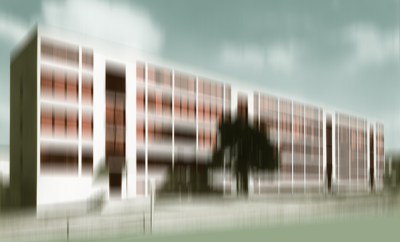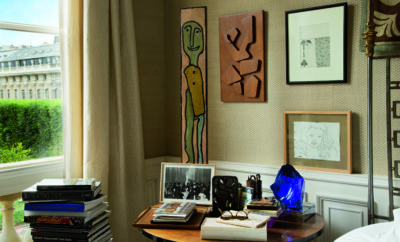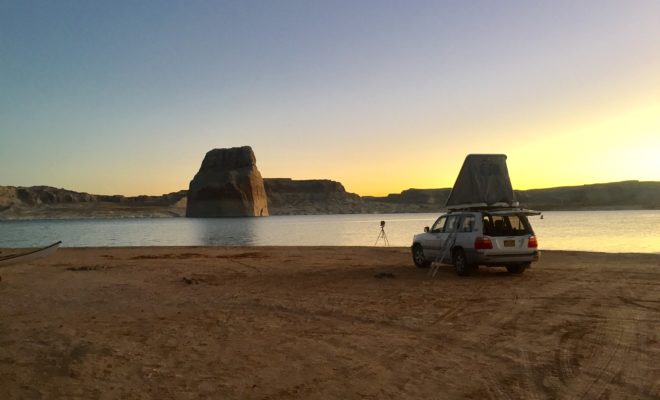 Samunaris's car-mounted Autohome and five-by-seven field camera at Lake Powell, Arizona. Victoria Sambunaris photo.
Samunaris's car-mounted Autohome and five-by-seven field camera at Lake Powell, Arizona. Victoria Sambunaris photo.
Feature
Itinerant Photographer: Victoria Sambunaris trains her lens on the landscape and industry of the West
Each year since 2000, photographer Victoria Sambunaris has structured her life and her work around a road trip across the US. The route changes each time, but the evidence and accouterments of industry—trains, semi-trucks, pipes, mines, highways—reappear consistently, juxtaposed against the raw beauty of the natural landscape. We had the opportunity to catch up with Sambunaris and ask her about her peregrinations, inspirations, and the photo-making process.
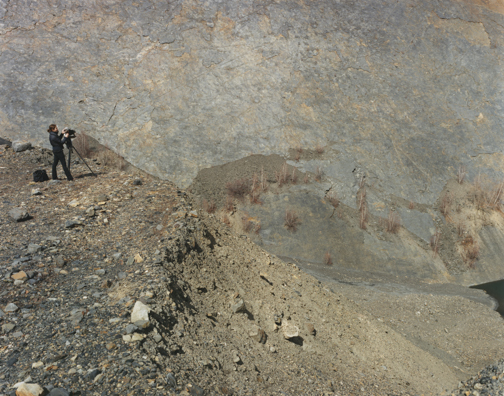
Victoria Sambunaris in the field. Jason Schmidt photo.
Sammy Dalati/MODERN MAGAZINE: What inspired you to make the work you do?
Victoria Sambunaris: Photography is a vehicle for making sense of the world. Personally, I have an almost philosophical or ethical need to explore, which I do through the camera. My work is project-based and my subject matter usually revolves around a notion about a situation or a phenomenon rather than something as specific as a mine or a pipeline. Sometimes a book, an article, or a conversation will inspire me enough that I’ll venture to a far-off region of the country to explore—gaining perspective through the local politics, geology, history, environment, and culture. For example, after years of carrying John McPhee’s book Annals of the Former World, in 2007 I decided to embark on a project centered on the book and examining the geology of I-80 from New Jersey to California.
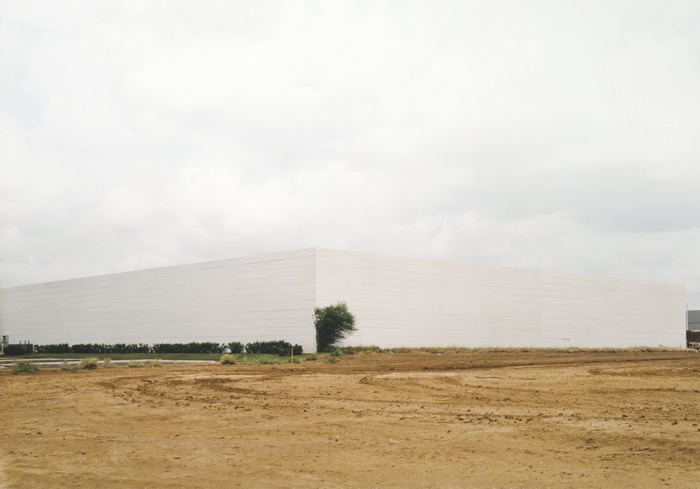
Untitled (White Building with Bush) by Sambunaris, Laredo, Texas, 2000. Courtesy of Victoria Sambunaris and Yancey Richardson Gallery.
MM: Can you walk us through the process of making the work on the road? And why do you use analogue technology?
VS: It all starts with my car: it’s my safety net, my home, my workplace, and it contains all I need in order to be on the road for months at a time. I have an Autohome—a type of tent mounted to the roof of the car—so I can camp anywhere.
I use a large-format five-by-seven field camera on a tripod and work with sheets of color negative film. The camera is very simple—just a box, a lens, and a piece of ground glass for viewing and focusing. I prefer the analogue process to digital for the amount of control it gives me, and the color, depth, detail, and precision that the film captures. It also slows down my process and forces me to observe more closely. There are none of the time-consuming distractions—failed batteries, computers, and various other bells and whistles—that a digital camera imposes as constraints.
Most of my time on the road is spent not making pictures, but rather driving, researching, scouting, revisiting, and waiting for the perfect light. I return to the same location multiple times, contemplate the shot, wait, look, wait again, and then maybe expose one or two sheets of film. Very often, I return to the same site on a different day, at a different time of year, and shoot the same thing again.
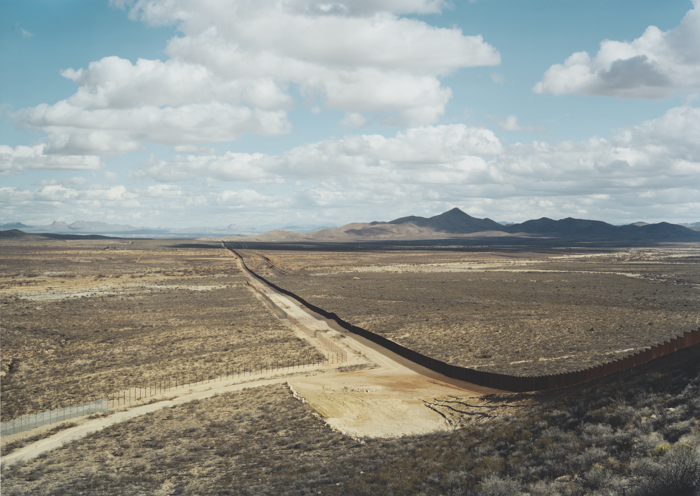
Untitled (Border Fence), near Naco, Arizona, 2010. Courtesy Victoria Sambunaris and Yancey Richardson Gallery.
MM: Your trips remind me of those of the intrepid early photographers—Darius Kinsey, Timothy O’Sullivan, Edward Curtis—who explored the West. Traveling is easier these days than it was when Kinsey photographed lumberjacks hacking their way through the Redwoods. But it’s still a great, long journey. Can you talk about your experience traversing the country in this way?
VS: I have great admiration for the photographers you mention and think about their lives and work frequently. I think about the challenges they were up against, what they were seeing and how those views have changed. While curating an exhibition at Brigham Young University last year, I read some of William Henry Jackson’s diaries. He wrote about the steak he had eaten that day at camp, how his and his companions’ horses disappeared overnight, and his disappointment with Echo Canyon, the historically prominent thoroughfare between Utah and Wyoming. I was struck by the monotony of his daily life as I read through the journals.
Access to today’s technology means my practice is vastly different, but the monotony is similar. Like Jackson, I maintain a journal. I also explore the towns, talk to locals, hear their stories and make discoveries each day. The key is to stay in the moment and to always stay curious.

Untitled (Echo Canyon, East) by Sambunaris, near Echo, Utah, 2007. Courtesy Victoria Sambunaris and Yancey Richardson Gallery.
MM: In the 2010s you did a project about the US-Mexico border. The immigration conversation has become particularly heated—what originally interested you about the border?
VS: My first encounter with the border area was in 2000 when I drove down to Laredo, Texas, to photograph new developments spurred on by the North America Free Trade Agreement. I was curious about the industrial structures springing up on both sides of the border. The buildings, which were surrounded by little vegetation, had no windows, and gave no sign of human life. I saw them as our modern-day monuments to the consumer goods hidden within. I was questioning what was missing from our lives that made it necessary to fill our homes, basements, garages and storage facilities with material possessions. In 2009 I returned to the region with a more expansive viewpoint after nearly ten years of exploring other parts of the country.
The tightening of the border is forcing us to confront certain truths about who we are, to confront issues relating to cheap labor, cheap consumer goods, illegal drugs, racism, corruption, terrorism, fear, and economic disparities.
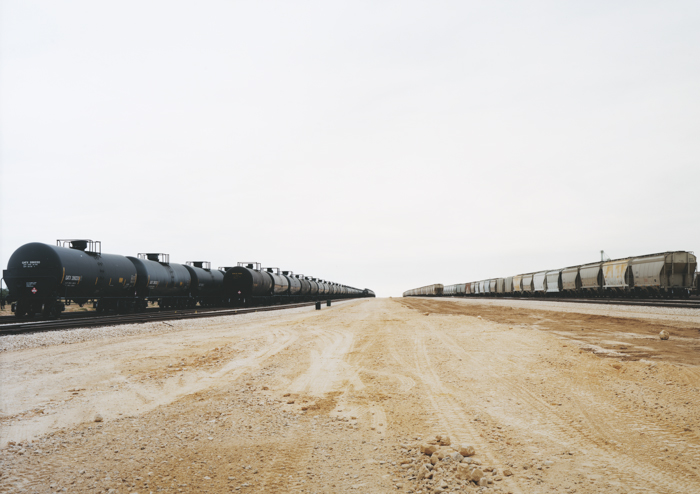
Untitled (Parallel Cars) by Sambunaris, near Cotulla, Texas, 2012. Courtesy Victoria Sambunaris and Yancey Richardson Gallery.
MM: What’s next?
VS: I’m leaving for Utah for several months. It’s too early to tell for sure what I’ll be doing, but I’m returning to earth, geology, mountains, strata, and rocks.



